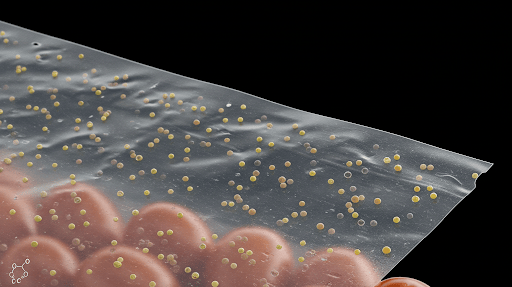Antimicrobial Polymer Sheets to Extend Shelf Life of Food Products: Crobion's Innnovation
PACKAGINGSUSTAINABILITY


This is an AI generated illustration and does not represent actual product or service.
Food spoilage due to bacterial contamination is a significant global challenge, leading to both health risks and substantial food waste. While preservatives are commonly used to extend the shelf life of food products, they are not always suitable, especially for minimally processed foods like fresh meat. In response to this issue, antimicrobial packaging has emerged as a promising solution. Purac Biochem BV (Corbion) has developed an innovative antimicrobial polymer sheet that addresses these challenges, offering a sustainable and effective way to enhance food preservation. This article explores the key aspects of this groundbreaking invention and its potential impact on the food packaging industry.
The Challenge of Antimicrobial Packaging
Creating effective antimicrobial packaging is no simple task. The packaging must meet several stringent requirements, including:
1. Antimicrobial Efficacy: The packaging must actively inhibit the growth of bacteria to extend the shelf life of the food product.
2. Manufacturability: The antimicrobial properties must not be compromised during the manufacturing process, such as extrusion, which involves high temperatures that can deactivate antimicrobial agents.
3. Compatibility: The packaging must be compatible with existing food packaging processes, such as vacuum sealing, without losing its antimicrobial effectiveness.
Traditional antimicrobial agents, such as lauric acid and its derivatives, have shown limited effectiveness when incorporated into polymer sheets. This limitation has created a need for new materials that can meet these demanding criteria.
The Innovation: Antimicrobial Polymer Sheets with Acyl Lactylates
Crobion’s patent pending invention centers on a polymer sheet that incorporates acyl lactylates, a class of compounds derived from fatty acids and lactic acid. These compounds are integrated into a vinyl polymer surface layer, which forms the outer layer of the packaging material. The key features of this innovation include:
1. Acyl Lactylates as Antimicrobial Agents: The polymer sheet contains 0.1 to 10 wt.% of C8-C16 acyl lactylates or their salts. These compounds are highly effective against both Gram-positive and Gram-negative bacteria, making them ideal for food packaging applications.
2. Vinyl Polymer Surface Layer: The surface layer is composed of vinyl polymers derived from alkylene monomers, such as ethylene and propylene. These polymers provide the necessary structural integrity while allowing the acyl lactylates to exert their antimicrobial effects.
3. Broad-Spectrum Antimicrobial Activity: The polymer sheet is particularly effective against common food spoilage bacteria, including Staphylococcus aureus, Listeria monocytogenes, and Escherichia coli. This makes it suitable for packaging a wide range of food products, from raw meat to dairy and fresh produce.
How It Works
The antimicrobial activity of the polymer sheet is achieved through the controlled release of acyl lactylates from the vinyl polymer matrix. When the packaging comes into contact with the food product, the acyl lactylates inhibit bacterial growth on the food’s surface. This mechanism is particularly effective in vacuum packaging, where the close contact between the packaging and the food maximizes the antimicrobial effect.
Key Advantages of the Invention
1. Enhanced Shelf Life: The antimicrobial properties of the polymer sheet significantly extend the shelf life of packaged food products, reducing food waste and improving food safety.
2. Sustainability: By reducing the need for chemical preservatives, this innovation aligns with the growing consumer demand for clean-label and minimally processed foods.
3. Manufacturing Compatibility: The polymer sheet can be produced using conventional extrusion processes, making it easy to integrate into existing packaging production lines.
4. Versatility: The invention is suitable for a wide range of food products, including raw meat, poultry, fish, dairy, fruits, and vegetables.
Applications and Impact
The antimicrobial polymer sheet has broad applications in the food packaging industry. It is particularly well-suited for:
- Vacuum Packaging of Meat: The polymer sheet can be used to package fresh meat, poultry, and fish, where bacterial contamination is a major concern.
- Dairy Products: Cheese and other dairy products can benefit from the extended shelf life provided by the antimicrobial packaging.
- Fresh Produce: Fruits and vegetables can be protected from spoilage bacteria, reducing waste and improving quality.
By combining the antimicrobial efficacy of acyl lactylates with the structural properties of vinyl polymers, this invention offers a sustainable and effective solution to the challenges of food spoilage and waste. As the demand for safer and longer-lasting food products continues to grow, this innovation is poised to play a crucial role in shaping the future of food packaging. The potential applications of this technology extend beyond food packaging. Future research could explore its use in medical packaging, where antimicrobial properties are equally critical. Additionally, optimizing the formulation for different types of food products and packaging methods could further enhance its effectiveness and market reach.


